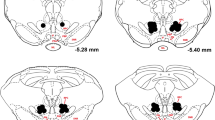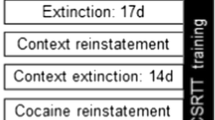Abstract
Rationale
Reduced central serotonin (5-HT) activity has been associated with impulsive choice behaviour, but there is no consensus about the precise nature of these effects. Behavioural and neurochemical effects of 5-HT1A agonists such as buspirone depend critically on the dose and the duration of treatment. We thus undertook a parametric study of the effects of acute and chronic buspirone on the performance on a test of delayed gratification, as well as on the efflux of serotonin and dopamine (DA) in cortical and subcortical regions in rats.
Objectives
Three experiments examined (i) the effects of acute buspirone on impulsive choice and how such effects were modified by prior chronic exposure to buspirone; (ii) the effects of chronic buspirone on impulsive choice; (iii) the effects on impulsive choice of a selective 5-HT1A antagonist, WAY-100635 tested alone and in combination with buspirone; (iv) the effects of chronic and acute buspirone on 5-HT and DA efflux in anaesthetised rats.
Methods
In experiment 1, rats previously trained on the delayed gratification task were tested with acute buspirone (0.5, 1 and 2 mg/kg). The same rats were then treated with chronic buspirone (1 mg/kg/day) over the next 65 days, and the effects of acute buspirone (1 mg/kg) re-determined at 20, 45 and 65 days of chronic treatment. In experiment 2, two groups of rats trained on the delayed gratification task were treated either with saline or buspirone (1 mg/kg/day) continually for 65 days before being tested with acute buspirone (1 mg/kg), WAY-100635 (0.08 mg/kg), or a combination of the two drugs. In experiment 3, rats received the same regimen of buspirone dosing as in experiment 2, before receiving in-vivo microdialysis for 5-HT and DA in the ventral hippocampus, nucleus accumbens and medial prefrontal cortex.
Results
Acute buspirone dose dependently increased the choice for the small, immediate reinforcer (impulsive choice) but the effects of 1 mg/kg were reversed on chronic administration of buspirone. This increased choice of the large, delayed reinforcer, which was not accompanied by any changes in baseline (non-drugged) performance, was blocked by the 5-HT1A receptor antagonist WAY-100635. The chronic buspirone regimen did not alter buspirone-evoked reductions in 5-HT efflux in hippocampus but did lead to a differential effect of acute buspirone in medial prefrontal cortex, with the chronic buspirone and saline groups exhibiting decreases and increases in efflux, respectively. There were no systematic changes in DA efflux under any condition.
Conclusions
These findings show that the effects of acute buspirone on impulsive choice are reversed following chronic treatment and are mediated by 5-HT1A receptors, and suggest, in addition, that the behavioural effects may involve changes in 5-HT functioning in medial prefrontal cortex.






Similar content being viewed by others
References
Ainslie G (1975) Specious reward: a behavioral theory of impulsiveness and impulse control. Psychol Bull 82:463–496
Algieri S, De Luigi A, De Simoni MG, Imeri L, Marconi M, Nava S, Perego C, Sacchetti G (1988) Multiple and complex effects of buspirone on central dopaminergic system. Pharmacol Biochem Behav 29:823–826
Bass EW Jr, Means LW, McMillen BA (1992) Buspirone impairs performance of a three-choice working memory water escape task in rats. Brain Res Bull 28:455–461
Bizot J, Le Bihan C, Puech AJ, Hamon M, Thiebot M (1999) Serotonin and tolerance to delay of reward in rats. Psychopharmacology 146:400–412
Blier P, de Montigny C (1990) Differential effect of gepirone on presynaptic and postsynaptic serotonin receptors: single-cell recording studies. J Clin Psychopharmacol 10[Suppl 3]:13S–20S
Blier P, de Montigny C (1994) Current advances and trends in the treatment of depression. Trends Pharmacol Sci 15:220–226
Cardinal RN, Robbins TW, Everitt BJ (2000) The effects of d-amphetamine, chlordiazepoxide, alpha-flupenthixol and behavioural manipulations on choice of signalled and unsignalled delayed reinforcement in rats. Psychopharmacology 152:362–375
Cardinal RN, Pennicott C, Sugathapala CL, Robbins TW, Everitt BJ (2001) Impulsive choice induced in rats by lesions of the nucleus accumbens core. Science 292:2499–2501
Charrier D, Thiebot MH (1996) Effects of psychotropic drugs on rat responding in an operant paradigm involving choice between delayed reinforcers. Pharmacol Biochem Behav 54:149–157
Cochran WG, Cox GM (1957) Experimental designs, 2nd edn. Wiley, New York
Corradetti R, Laaris N, Haroun N, Laporte AM, Le Poul E, Hamon M, Lanfumey L (1998) Antagonist properties of (−)-pindolol and WAY 100635 at somatodendritic and postsynaptic 5-HT1A receptors in the rat brain. Br J Pharmacol 123:449–462
Dalley JW, Mason K, Stanford SC (1996) Increased levels of extracellular noradrenaline in the frontal cortex of rats exposed to naturalistic environmental stimuli: modulation by acute systemic administration of diazepam or buspirone. Psychopharmacology 127:47–54
Dalley JW, Theobald DE, Eagle DM, Passetti F, Robbins TW (2002a) Deficits in impulse control associated with tonically-elevated serotonergic function in rat prefrontal cortex. Neuropsychopharmacology 26:716–728
Dalley JW, Theobald DE, Pereira EAC, Li PMMC, Robbins TW (2002b) Specific abnormalities in serotonin release in the prefrontal cortex of isolation reared rats measured during behavioural performance of a task assessing visuospatial attention and impulsivity. Psychopharmacology 164:329–340
De Vry J (1995) 5-HT1A receptor agonists: recent developments and controversial issues. Psychopharmacology 121:1–26
Done CJG, Sharp T (1994) Biochemical evidence for the regulation of central noradrenergic activity by 5-HT1A and 5-HT2 receptors: microdialysis studies in the awake and anaesthetised rat. Neuropharmacology 33:411–421
Evenden JL (1999) Varieties of impulsivity. Psychopharmacology 146:348–361
Evenden JL, Ryan CN (1996) The pharmacology of impulsive behaviour in rats: the effects of drugs on response choice with varying delays of reinforcement. Psychopharmacology 128:161–170
Evenden JL, Ryan CN (1999) The pharmacology of impulsive behaviour in rats. VI. The effects of ethanol and selective serotonergic drugs on response choice with varying delays of reinforcement. Psychopharmacology 146:413–421
Fabre LF (1990) Buspirone in the management of major depression: a placebo-controlled comparison. J Clin Psychiatry 51[Suppl]:55–61
Goa KL, Ward A (1986) Buspirone: a preliminary review of its pharmacological properties and therapeutic efficacy as an anxiolytic. Drugs 32:115–129
Hamon M, Fattaccini CM, Adrien J, Gallissot MC, Martin P, Gozlan H (1988) Alterations of central serotonin and dopamine turnover in rats treated with ipsapirone and other 5-hydroxytryptamine1A agonists with potential anxiolytic properties. J Pharmacol Exp Ther 246:745–752
Hjorth S, Carlsson A (1982) Buspirone: effects on central monoaminergic transmission—possible relevance to animal experimental and clinical findings. Eur J Pharmacol 83:299–303
Ho MY, Al-Zahrani SS, Al-Ruwaitea AS, Bradshaw CM, Szabadi E (1998) 5-hydroxytryptamine and impulse control: prospects for a behavioural analysis. J Psychopharmacol 12:68–78
Howell DC (1997) Statistical methods for psychology, 4th edn. Wadsworth, Belmont, California
Jacobs BL, Azmitia EC (1992) Structure and function of the brain serotonin system. Physiol Rev 72:165–229
Kheramin S, Body S, Mobini S, Ho MY, Velazquez-Martinez DN, Bradshaw CM, Szabai E, Deakin JFW, Anderson IM (2002) Effects of quinolinic acid-induced lesions of the orbital prefrontal cortex on inter-temporal choice: a quantitative analysis. Psychopharmacology 165:9–17
Linnoila M, Virkunenen M, Scheinin M, Nuutila A, Rimon R, Goodwin FK (1983) Low cerebro-spinal fluid 5-hydroxyindoleacetic acid concentration differentiates impulsive form non-impulsive violent behavior. Life Sci 33:2609–2614
Markowitz PJ, Stagno SJ, Calabrese JR (1990) Buspirone augmentation of fluoxetine in obsessive-compulsive disorder. Am J Psychiatry 147:798–800
McMillen BA, Matthews RT, Sanghera MK, Shepard PD, German DC (1983) Dopamine receptor antagonism by the novel antianxiety drug, buspirone. J Neurosci 3:733–738
Mobini S, Chiang TJ, Ho MY, Bradshaw CM, Szabadi E (2000) Effects of central 5-hydroxytryptamine depletion on sensitivity to delayed and probabilistic reinforcement. Psychopharmacology 152:390–397
Murasaki M, Miura S (1992) The future of 5-HT1A receptor agonists (aryl-piperazine derivatives). Prog Neuropsychopharmacol Biol Psychiatry 16:833–845
Passetti F, Dalley JW, Robbins TW (2003) Double dissociation of serotoninergic and dopaminergic mechanisms in attentional performance using a rodent five-choice reaction time task. Psychopharmacology 165:136–145
Pellegrino JJ, Pellegrino AS, Cushman AJ (1979) A stereotaxic atlas of the rat brain. Plenum, New York
Piercey MF, Smith MW, Lum-Ragan JT (1994) Excitation of noradrenergic cell firing by 5-HT1A agonists correlates with dopamine antagonist properties. J Pharm Exp Ther 268:1297–1303
Poulos CX, Parker JL, Le AD (1996) Dexfenfluramine and 8-OH-DPAT modulate impulsivity in a delay-of-reward paradigm: implication for a correspondence with alcohol consumption. Behav Pharmacol 7:395–399
Puumala T, Sirvio J (1998) Changes in activities of dopamine and serotonin systems in the frontal cortex underlie poor choice accuracy and impulsivity of rats in an attention task. Neuroscience 83:489-499
Richards JB, Mitchell SH, de Wit H, Seiden LS (1997) Determination of discount functions in rats with an adjusting-amount procedure. J Exp Anal Behav 67:353–366
Rickels K, Schweizer E, Csanalosi I, Case WG, Chung H (1988) Long-term treatment of anxiety and risk of withdrawal. Prospective comparison of clorazepate and buspirone. Arch Gen Psychiatry 45:444–450
Robinson DS, Alms DR, Shrotriya RC, Messina M, Wickramaratne P (1989) Serotonergic anxiolytics and treatment of depression. Psychopathology 22[Suppl 1]:27–36
Rodriguez ML, Logue AW (1988) Adjusting delay to reinforcement: comparing choice in pigeons and humans. J Exp Psychol Anim Behav Process 14:105–117
Sharp T, McQuade R, Bramwell S, Hjorth S (1993) Effect of acute and repeated administration of 5-HT1A receptor agonists on 5-HT release in rat brain in vivo. Naunyn Schmiedebergs Arch Pharmacol 348:339–346
Sharp T, Umbers V, Gartside S (1997) Effect of a selective 5-HT reuptake inhibitor in combination with 5-HT1A and 5-HT1B receptor antagonists on extracellular 5-HT in rat frontal cortex in vivo. Br J Pharmacol 121:941–946
Soubrié P (1986) Reconciling the role of central serotonin neurons in human and animal behavior. Behav Brain Sci 9:319–364
Sprouse JS, Aghajanian GK (1987) Electrophysiological responses of serotoninergic dorsal raphé neurons to 5-HT1A and 5-HT1B agonists. Synapse 1:3–9
Winstanley CA, Dalley JD, Theobald DEH, Robbins TW (2003a) Global 5-HT depletion attenuates the ability of amphetamine to decrease impulsive choice on a delay-discounting task in rats. Psychopharmacology 170:320–331
Winstanley CA, Dalley JD, Chudasama Y, Theobald DEH, Robbins TW (2003b) Intra-prefrontal 8-OH-DPAT and M100907 improve visuospatial attention and decrease impulsivity on the five-choice serial reaction time task in rats. Psychopharmacology 167:304–315
Wogar M, Bradshaw CM, Szabadi E (1993) Effects of lesions of the ascending 5-hydroxytryptaminergic pathways on choice between delayed reinforcers. Psychopharmacology 111:239–243
Acknowledgements
We should like to thank Drs. Kendrick and Dyer for the facilities provided by the Neurobiology Programme at the Babraham Institute and Dr. R. Cardinal, Dr. T. Humby and Mr. C. de la Riva for their helpful advice and assistance. We also thank Drs. J.W. Dalley and C.A. Winstanley for their helpful comments on the manuscript. This research was supported by a Wellcome Trust programme grant to T.W.R. and by a scholarship from the government of Taiwan to Dr. Yia-Ping Liu. The work was completed within the MRC Cambridge Centre in Behavioural and Clinical Neuroscience.
Author information
Authors and Affiliations
Corresponding author
Rights and permissions
About this article
Cite this article
Liu, Y.P., Wilkinson, L.S. & Robbins, T.W. Effects of acute and chronic buspirone on impulsive choice and efflux of 5-HT and dopamine in hippocampus, nucleus accumbens and prefrontal cortex. Psychopharmacology 173, 175–185 (2004). https://doi.org/10.1007/s00213-003-1726-1
Received:
Accepted:
Published:
Issue Date:
DOI: https://doi.org/10.1007/s00213-003-1726-1




